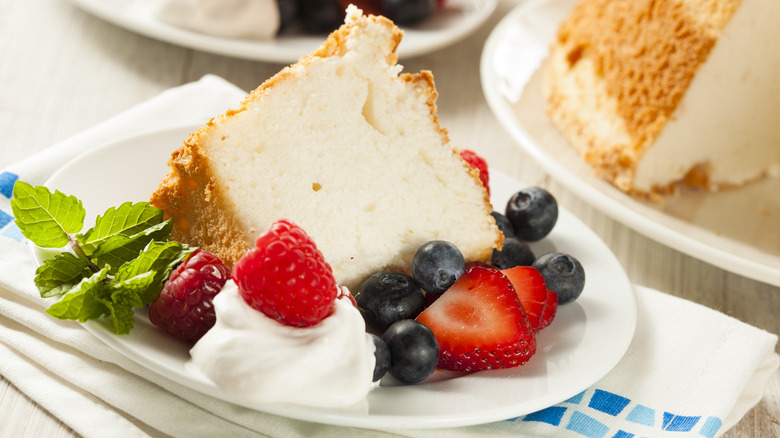Why It's Really Called Angel Food Cake
If not for the 19th-century invention of the rotary eggbeater, the light and fluffy delicacy that is angel food cake might never have become as popular as it is today. Enjoyed under a layer of fruit, maybe with a dollop of whipped cream — or just plain — angel food cake can be traced to a sponge cake recipe included in "The Kentucky Housewife," an American cookbook published in 1839. Almost 40 years later, in 1878, the second edition of "The Home Messenger Book of Tested Recipes" included instructions for making an "Angel's Food" cake, per the food blog Researching Food History. The blog also includes a reference to an 1884 recipe for "Angel Cake" appearing in that year's edition of the Boston Cooking School Cookbook.
Making angel food cake requires whipping egg whites to give the cake its structure. There is a lot of whipping required for an angel food cake, with the 1878 and 1884 recipes calling for beating the whites of 11 eggs. It would, then, have been perfectly understandable if making an angel food cake produced less-than-angelic thoughts, and maybe even words, from any cook embarking on a recipe. The hand-powered rotary eggbeater had been patented in America in 1857, and by 1880, per HomeThingsPast, it had taken the form still in use today. But as HomeThingsPast noted, mechanical eggbeaters initially may not have been particularly popular, with some people likely "influenced against the new eggbeaters by cookery experts who didn't think highly of new-fangled devices."
How angel food cake got its name
How angel food cake got its name isn't clear, but popular culture has settled on the belief, expressed at Just Fun Facts, that the name notes the cake's "texture, which is 'so light that angels could eat it and still fly without being weighted down.'" Just Fun Facts solidifies the cake's connection with the angelic by noting that in Black culture, it is frequently served at funeral receptions "with the idea that the deceased person is now living in Heaven among the angels." At Love to Know, angel food cake is listed among the cakes appropriate for serving at a funeral reception, along with other cakes like sponge cake, carrot cake, red velvet cake, and coffee cake.
Love to Know also offers tips on how to serve cake at a funeral reception, recommending that slices be pre-cut, and for a formal reception, also be plated. Of course, slicing an angel food cake can be a problem, as its light sponginess makes it vulnerable to being squished with a regular knife. But there are a couple of tricks for getting attractive slices of angel food cake. One is simply to use a serrated knife. An electric knife is another option. Otherwise, there's a kitchen tool informally called a cake rake — a row of long prongs at the end of a handle — that perforate the cake for gentle separation of the slices. Or, you can try this YouTube hack using (preferably unflavored) dental floss.

